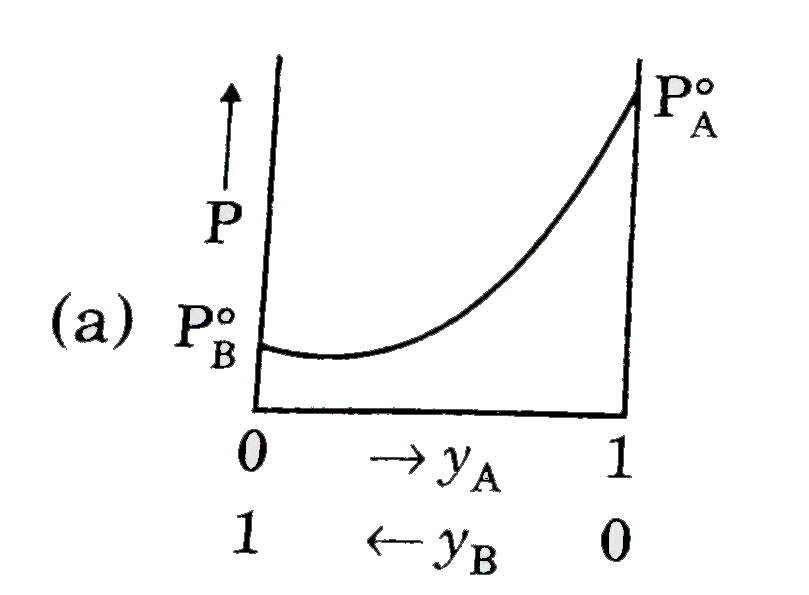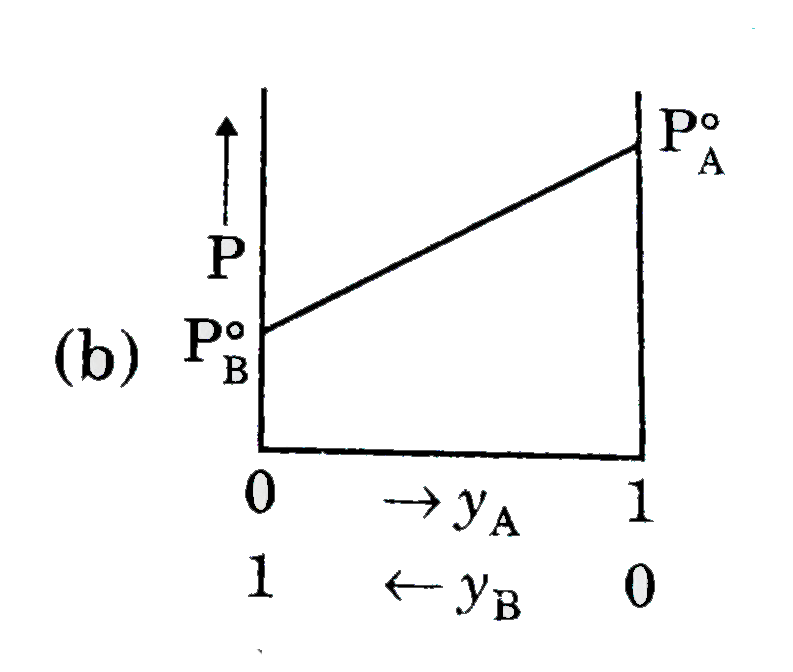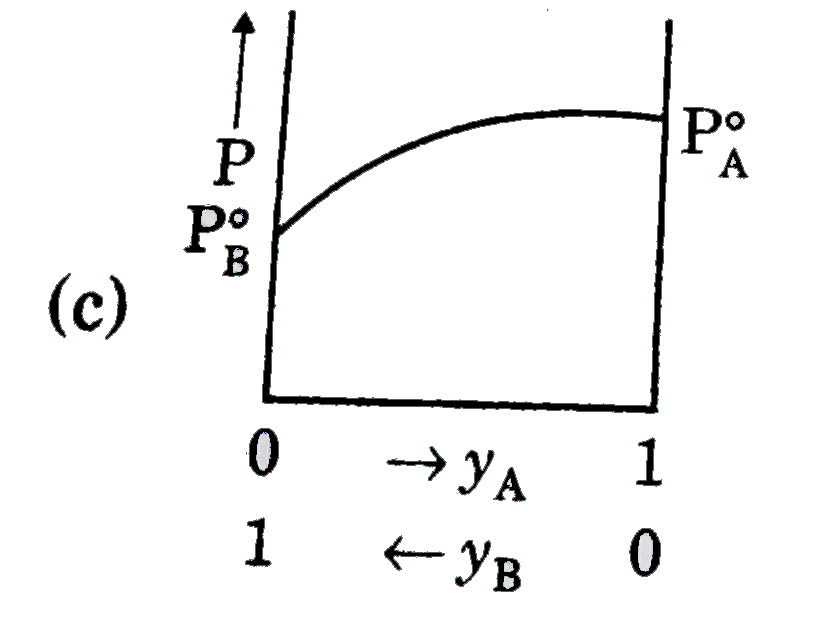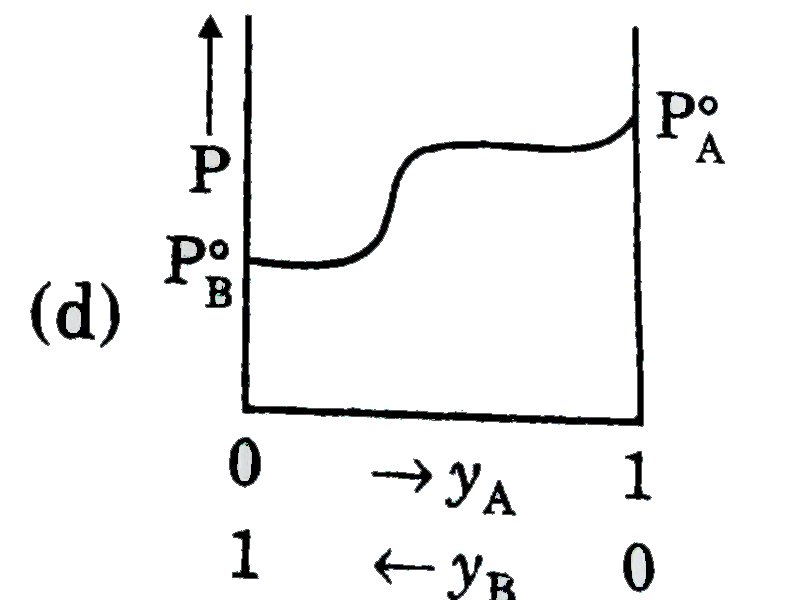When a liquid is completely miscible with another liquid, a homogeneous solution consisting of a single phase is formed. If such a solution is placed in a closed evacuated vessel, the total pressure exerted by the vapour, after the system attained equilibrium will be equal to the sum of partial pressures of the constituents. A solution is said to be ideal if its constituents follow Raoult's law under all conditions of concentrations, i.e., where pi is the partial pressures of the constituent i, whose mole fraction in the solution is xi and p∘i is the corresponding vapour pressure of the pure constituent. The change in the thermodynamic functions when an ideal solution is formed by mixing pure components is given by the following expression.
Δmix=G=ntotalRT∑ixiInxi ...(i)
where, ntotal is the total amount of all the constituents present in the solution.
ΔmixF=−ntotalR∑ixiInxi ......(ii)
ΔmixH=−ntotalRT∑ixiInxi−ntotalR∑ixiInxi=0 ........(iii)
ΔmixU=0 .........(iv)
Since botli the components of an ideal binary system follow Raoult's law of the entire range of the compositions, the partial pressure exerted by the vapours of these constituents over the solution will be given by
pA=xAp∘A ..........(v)
pB=xBp∘B .........(vi)
where, xA and xB are the mole fractions of the two constituents in the liquid phase and p∘A and p∘B are the respective vapour pressure of the pure constituents. The total pressure (p) over the solution will be the sum of the partial pressure. The composition of the vapour phase (yA) can be determined with the help of Dalton's law of partial pressures.
Two liquids A and B form an ideal solution at temperature T. when the total vapour pressure above the solution is 600 torr, the mole fraction of A in the vapour phase is 0.35 and in the liquid phase 0.70. The vapour pressure of pure B and A are:
800 torr, 1300 torr
1300 torr, 300 torr
300 torr, 1300 torr
300 torr, 800 torr
The correct Answer is:B
Step by step video, text & image solution for When a liquid is completely miscible with another liquid, a homogeneous solution consisting of a single phase is formed. If such a solution is placed in a closed evacuated vessel, the total pressure exerted by the vapour, after the system attained equilibrium will be equal to the sum of partial pressures of the constituents. A solution is said to be ideal if its constituents follow Raoult's law under all conditions of concentrations, i.e., where p_(i) is the partial pressures of the constituent i, whose mole fraction in the solution is x_(i) and p_(i)^(@) is the corresponding vapour pressure of the pure constituent. The change in the thermodynamic functions when an ideal solution is formed by mixing pure components is given by the following expression. Delta_(mix) = G = n_("total") RT sum_(i) x_(i) In x_(i) ...(i) where, n_("total") is the total amount of all the constituents present in the solution. Delta_(mix)F =- n_("total") R sum_(i) x_(i) In x_(i) ......(ii) Delta_(mix)H =- n_("total") RT sum_(i) x_(i) In x_(i) - n_("total") R sum_(i) x_(i) In x_(i) = 0 ........(iii) Delta_(mix) U = 0 .........(iv) Since botli the components of an ideal binary system follow Raoult's law of the entire range of the compositions, the partial pressure exerted by the vapours of these constituents over the solution will be given by p_(A) = x_(A) p_(A)^(@) ..........(v) p_(B) = x_(B) p_(B)^(@) .........(vi) where, x_(A) and x_(B) are the mole fractions of the two constituents in the liquid phase and p_(A)^(@) and p_(B)^(@) are the respective vapour pressure of the pure constituents. The total pressure (p) over the solution will be the sum of the partial pressure. The composition of the vapour phase (y_(A)) can be determined with the help of Dalton's law of partial pressures. Two liquids A and B form an ideal solution at temperature T. when the total vapour pressure above the solution is 600 torr, the mole fraction of A in the vapour phase is 0.35 and in the liquid phase 0.70. The vapour pressure of pure B and A are: by Chemistry experts to help you in doubts & scoring excellent marks in Class 12 exams.
Updated on:21/07/2023Topper's Solved these Questions
- GRAPHICAL INTERPRETATIONBook:GRB PUBLICATIONChapter:GRAPHICAL INTERPRETATIONExercise:Comprehension 2
Explore 1 Video
- GRAPHICAL INTERPRETATIONBook:GRB PUBLICATIONChapter:GRAPHICAL INTERPRETATIONExercise:Comprehension 3
Explore 1 Video
- GRAPHICAL INTERPRETATIONBook:GRB PUBLICATIONChapter:GRAPHICAL INTERPRETATIONExercise:Comprehension 1
Explore 1 Video
- F-BLOCK ELEMENTSBook:GRB PUBLICATIONChapter:F-BLOCK ELEMENTSExercise:Subjective type
Explore 7 Videos
- HYDROCARBON (ALIPHATIC)Book:GRB PUBLICATIONChapter:HYDROCARBON (ALIPHATIC)Exercise:Previous years jee questions
Explore 28 Videos
Similar Questions
Two liquids A and B form an ideal solution at temperature T. When the total vapour pressure above the solution is 400 torr, the mole fraction of A in the vapour phase is 0.40 and in the liquid phase 0.75. What are the vapour pressure of pure A and pure B at temperature T?
View SolutionTwo liquid A and B form an ideal solution at temperature T. When the total vapour pressure above the solution is 400 torr , the mole fraction of A in the vapour phase is 0.40 and in the liquid phase 0.75. What are the vapour pressure of pure A and pure B at temperature T ?
View Solution
Knowledge Check
When a liquid is completely miscible with another liquid, a homogeneous solution consisting of a single phase is formed. If such a solution is placed in a closed evacuated vessel, the total pressure exerted by the vapour, after the system attained equilibrium will be equal to the sum of partial pressures of the constituents. A solution is said to be ideal if its constituents follow Raoult's law under all conditions of concentrations, i.e., where pi is the partial pressures of the constituent i, whose mole fraction in the solution is xi and p∘i is the corresponding vapour pressure of the pure constituent. The change in the thermodynamic functions when an ideal solution is formed by mixing pure components is given by the following expression.
Δmix=G=ntotalRT∑ixiInxi ...(i)
where, ntotal is the total amount of all the constituents present in the solution.
ΔmixF=−ntotalR∑ixiInxi ......(ii)
ΔmixH=−ntotalRT∑ixiInxi−ntotalR∑ixiInxi=0 ........(iii)
ΔmixU=0 .........(iv)
Since botli the components of an ideal binary system follow Raoult's law of the entire range of the compositions, the partial pressure exerted by the vapours of these constituents over the solution will be given by
pA=xAp∘A ..........(v)
pB=xBp∘B .........(vi)
where, xA and xB are the mole fractions of the two constituents in the liquid phase and p∘A and p∘B are the respective vapour pressure of the pure constituents. The total pressure (p) over the solution will be the sum of the partial pressure. The composition of the vapour phase (yA) can be determined with the help of Dalton's law of partial pressures.
A plot of reciprocal of total pressure (1p) (y-axis) us yA (x-axis) gives :Aa linear plot with slope =(1p∘B−1p∘A)Ba linear plot with slop =(1p∘A−1p∘B)Ca linear plot with slope =1p∘BDa linear plot with slope =p∘Ap∘BWhen a liquid is completely miscible with another liquid, a homogeneous solution consisting of a single phase is formed. If such a solution is placed in a closed evacuated vessel, the total pressure exerted by the vapour, after the system attained equilibrium will be equal to the sum of partial pressures of the constituents. A solution is said to be ideal if its constituents follow Raoult's law under all conditions of concentrations, i.e., where pi is the partial pressures of the constituent i, whose mole fraction in the solution is xi and p∘i is the corresponding vapour pressure of the pure constituent. The change in the thermodynamic functions when an ideal solution is formed by mixing pure components is given by the following expression.
Δmix=G=ntotalRT∑ixiInxi ...(i)
where, ntotal is the total amount of all the constituents present in the solution.
ΔmixF=−ntotalR∑ixiInxi ......(ii)
ΔmixH=−ntotalRT∑ixiInxi−ntotalR∑ixiInxi=0 ........(iii)
ΔmixU=0 .........(iv)
Since botli the components of an ideal binary system follow Raoult's law of the entire range of the compositions, the partial pressure exerted by the vapours of these constituents over the solution will be given by
pA=xAp∘A ..........(v)
pB=xBp∘B .........(vi)
where, xA and xB are the mole fractions of the two constituents in the liquid phase and p∘A and p∘B are the respective vapour pressure of the pure constituents. The total pressure (p) over the solution will be the sum of the partial pressure. The composition of the vapour phase (yA) can be determined with the help of Dalton's law of partial pressures.
For an ideal solution in which p∘A>p∘B, the plot of total pressure (p) us the mole fraction of A at constant temperature in the vapour phase is:A B
B C
C D
D
An ideal solution is formed when its constituents:
Aare converted into ideal gasesBhave zero volume changeChave zero heat of mixingDboth (2) and (3) are correct
An ideal solution follows Raoult's law over all ranges of concentrations and pressure.
View SolutionSolution of two volatile liquids x and y obey Raoult's law. At a certain temperature it is found that when the total pressure above a given solution is 400mm of Hg, the mole fraction of x in the vapour is 0.45 and in the liquid is 0.65. What are the vapour pressures of two pure liquids at the given temperature?
View SolutionSolution of two volatile liquids x and y obey Raoult's law. At a certain temperature it is found that when the total pressure above a given solution is 400mm of Hg, the mole fraction of x in the vapour is 0.45 and in the liquid is 0.65. What are the vapour pressures of two pure liquids at the given temperature?
View SolutionA solution of two volatile liquids A and B obeys Raoult's law. At a certain temperature it is found that when the pressure above the mixture in equilibrium is 402.5 mm of Hg, the mole fraction of A in the vapour is 0.35 and in the liquid it is 0.65. What are the vapour pressures of two liquids at this temperature ?
View SolutionThe vapour pressure of a liquid in a closed container depends upon
View Solution